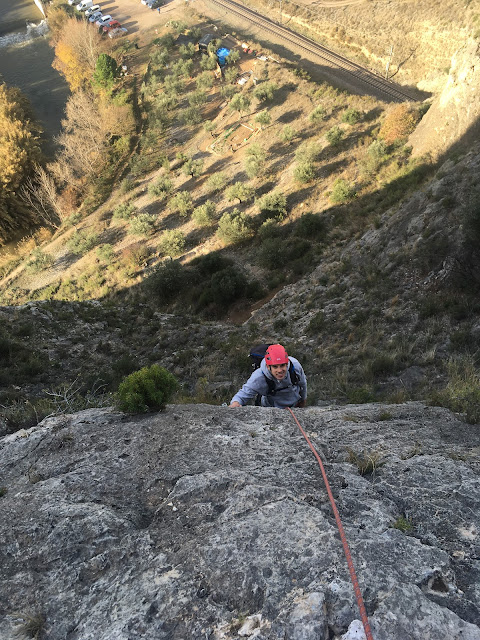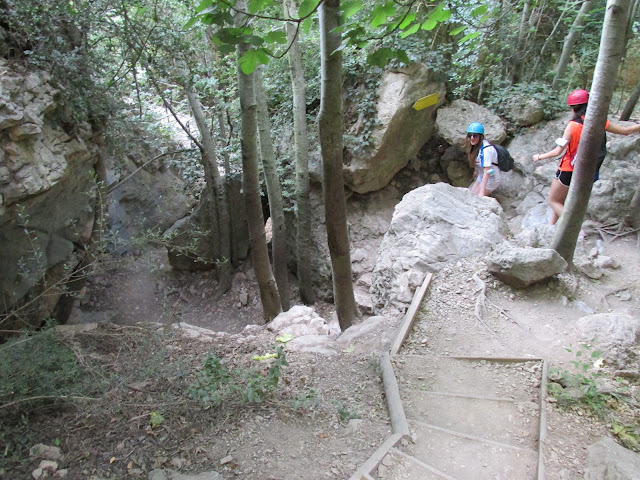Menu
- Viajes
- Escalada
domingo, 13 de diciembre de 2020
Vías Bruno Vera y Cintero, Las Torcas de Chodes, Morata de Jaón, Zaragoza
jueves, 17 de septiembre de 2020
Vía Ferrata Espolón de la Virgen, Rodellar, Huesca, España
Via Ferrata Espolón de la Virgen (Virgin Buttress), Rodellar, Huesca, Spain
Después de hacer las pasarelas de Alquezar, nos dirigimos a Rodellar.
Con la intención de hacer la ferrata del Espolón de la Virgen.
After visiting the footbridges, we headed to Rodellar.
With the intention of climbing the Via Ferrata Espolon de la Virgen (Virgin
Buttress).
Una vez ya en Rodellar, aparcamos en el parking situado debajo
de la carretera. Tras aparcar fuimos hacia la iglesia de San Juan Bautista, y
seguimos los carteles indicadores de las zonas de escalada.
Once in Rodellar, we parked at the car park located below
the road. After parking, we went towards the San Juan Bautista church, once
there, we carried on following the signs to the rock climbing area.
Para hacer una ruta circular, decidimos bajar directamente hacia
el cañón del río Mascún, siguiéndolo hasta que llegamos a una playa de piedras,
donde se encuentra la ferrata.
As we preferred to do a circular route, we decided to
go down into the canyon of Mascun river, following its course until we reached to
a “Stony bay”, where the ferrata is located.
La vía ferrata es sencilla y bien equipada, está se compone
principalmente por grapas y algunos tramos de cadenas, tiene un par de partes en
una pared vertical, muy bonitas y expuestas. Termina en la base de la Ermita de
la Virgen
The vía ferrata is quite easy and well belayed with
staples and chains, it has a couple parts on a vertical wall, very thrilling and
exposed. It end at the base of the Ermita de la Virgen (Virgin Hermitage).
Desde la Ermita de la Virgen, sale un sendero que lleva de
vuelta a Rodellar.
From the Hermitage, there is a footpath that leads
back to the Rodellar.
miércoles, 19 de agosto de 2020
Alquezar - Pasarelas del Vero - Asque, Sierra de Guara, Spain
Alquezar - Vero footbridges - Asque, Sierra de Guara, Spain
A las 7 de la mañana, recogí a Natalie y Orlaith, y pusimos rumbo hacia Alquézar, un pequeño pueblo medieval localizado en la Comarca del Somontano, en el Parque Natural de la Sierra de de Guara.
At 7 am I picked up Natalie and Orlaith, so we were heading to Alquezar, a small medieval village located in the región of El Somontano, in
Sierra de Guara National Park.
Al llegar a Alquezar, decidimos hacer la ruta que va desde
Alquezar hasta Asque, pasando por las pasarelas del río Vero.
Once in Alquezar, we decided to walk the route that
goes from Alquezar to Asque, going through the river Vero footbridges.
Iniciamos el camino descendiendo por el barranco de la
Fuente hasta llegar al lecho del río. Para ello se han instalado numerosos
puentes y escaleras de madera para facilitar el descenso.
We began the route descending to the sidebed of the river
Vero through the Barranco de la Fuente (Canyon of the fountain). There are
settled numeorus wooden bridges and wooden stairs to make easier the descend.
When we got to the river sidebed, we went to the left,
towards the Picamartillos Cave.
After visiting the cave, we headed to the footbridges.
The footbridges are nailed to the canyon walls, allowing us to miss river.
Tras pasar la primera pasarela llegamos al Azud, donde hay
una pequeña cascada, y donde ¡¡POR SUPUESTO!! Natalie y Orlaith se dieron un baño.
After passing the first walkway, we got to a small dam,
where there is a small waterfall and OF COURSE!! Natalie and Orlaith could not
miss the chance of going for a swim.
El recorrido de las pasarelas termina en el mirador, donde
hay una magnífica vista panorámica de toda el área que lo rodea.
The vero walkways route ends at the Vero viewpoint, where there a magnificent panoramic view of all the area around it.
Desde el mirador salen dos caminos, uno ascendente de retorno a Alquezar y el que tomamos nosotros que se dirige a Asque, un pequeño poblado situado a 4 km de Alquezar.
Two paths leave the point view. An ascending one that
goes back to Alquezar and the one we took that goes to Asque, a very small
village located 4 km away from Alquezar.
El camino de Asque va sobre la colina situada enfrente de
Alquezar, por lo que permite una gran vista del pueblo y el valle.
The Asque road goes over the hill located in from of
Alquezar, so it allows a great view of the village and the valley.
En Asque tomamos algo en la posada y volvimos a Alquezar.
In Asque we had a drink in its inn, afterwards we headed
back to Alquezar.
























































